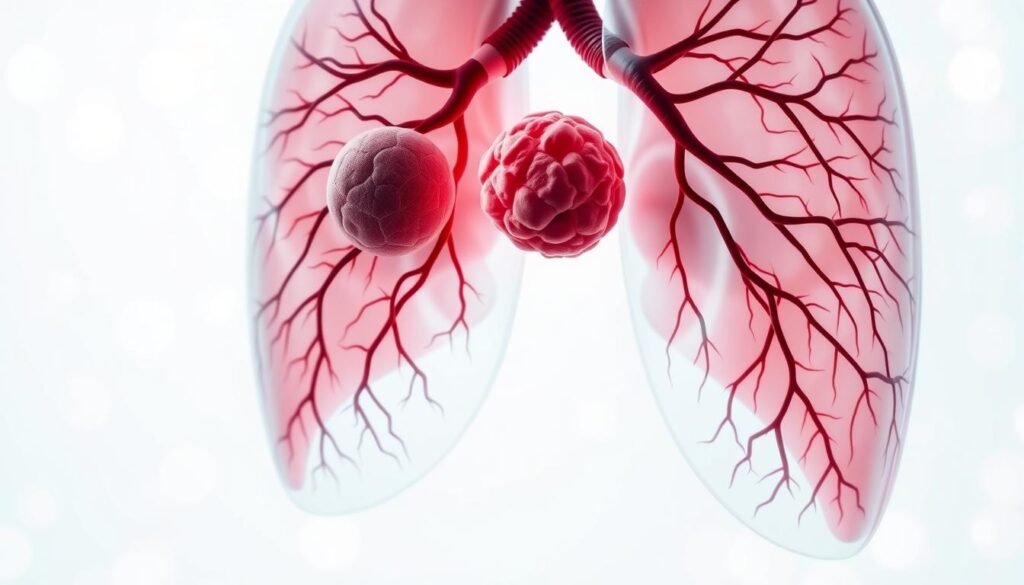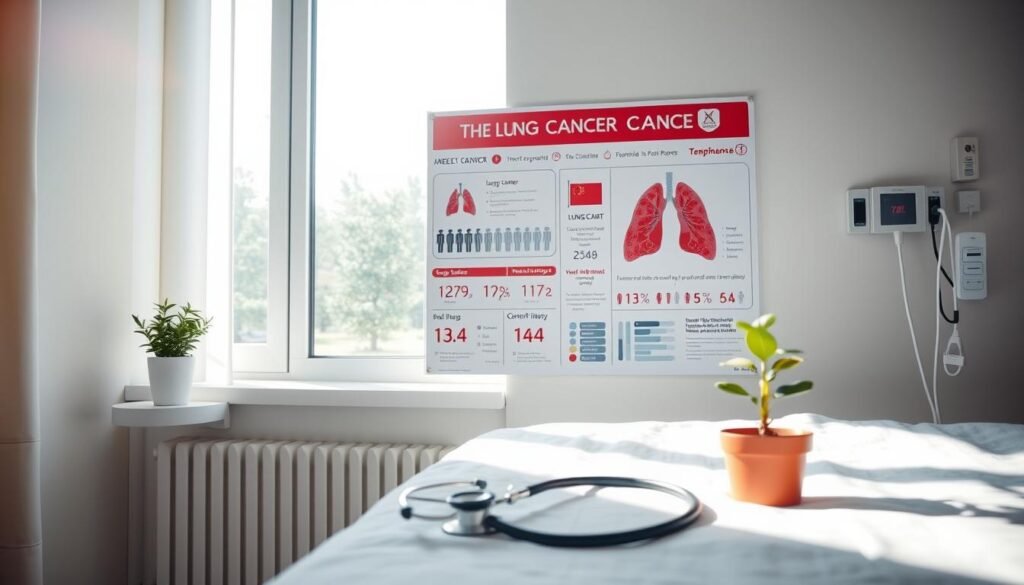Did you know over half of people with stage II lung cancer live five years or more? This fact shows how crucial it is to understand the stage 2A lung cancer survival rate. Early symptoms, such as constant coughing and unexplained weight loss, are key for fast treatment and better results. About 60% survive stage 2A, showing early detection and successful lung cancer treatment options matter a lot.
This article sheds light on stage 2A lung cancer, including what influences survival rate, and ways to treat it. Knowing these can help patients and their families through this tough time. It makes deciding on care easier.
Learning to spot lung cancer’s early symptoms could save your life. So, staying informed is important.
Key Takeaways
- Stage 2A lung cancer has a five-year survival rate of around 60%.
- Recognizing early-stage lung cancer symptoms is vital for improving outcomes.
- Treatment options include surgery, chemotherapy, and radiation.
- Survival rates can vary based on factors like age and smoking status.
- More than half of stage II lung cancer patients live five years or longer.
- Regular follow-up care is essential after treatment to monitor health.
Understanding Stage 2 Non-Small Cell Lung Cancer
Stage 2 non-small cell lung cancer (NSCLC) is a crucial phase of the illness. It shows the tumor is growing but hasn’t reached distant organs. Patients must understand this stage deeply as they explore lung cancer diagnosis and treatment paths. At stage 2A, the tumor is typically 4 to 5 centimeters big. It may also spread to nearby lung tissue but not the lymph nodes.
Knowing the exact stage is key to finding the right treatment. The American Joint Committee on Cancer provides specific for this. Doctors use them to assess each case. Treatments usually mix surgery, chemotherapy, and immunotherapy. This mix aims to improve the patient’s chances of survival.
Handling stage 2 NSCLC well is about getting the best results. Surgery can greatly help if it removes the tumor completely. Realizing how crucial early detection is can also boost survival rates.
What is Stage 2A Lung Cancer?
Stage 2A lung cancer is a type of non-small cell lung cancer. It is based on the size of the tumor, which is usually between 4 and 5 centimeters. At this stage, the cancer might spread to nearby tissues but not to close lymph nodes. This follows the lung cancer staging criteria, helping to understand the cancer’s level.
The TNM staging system is crucial for defining stage 2A lung cancer. It looks at tumor size (T), lymph node status (N), and if the cancer has spread far (M). For stage 2A, these details help doctors decide on the best treatment path and predict outcomes. Knowing the stage helps with planning the treatment.

For more details on stage 2A lung cancer, including ways to treat it and what to expect, check out this detailed source.
Stage 2A Lung Cancer Survival Rate
Understanding stage 2A lung cancer survival rates is key. It gives us a look into how serious this disease is. For those with stage 2A non-small cell lung cancer (NSCLC), the survival rate over five years is about 60% to 75%. This is a relatively good sign when compared to later stages.
But remember, these numbers don’t fit everyone’s situation. Each person’s journey with cancer is unique.
Five-Year Survival Rates Explained
The five-year survival rate is vital for measuring treatment success and outcomes. For stage 2A, cancer is still in its early stages. It’s usually not larger than five centimeters and hasn’t spread to nearby lymph nodes. This means patients have a better chance to fight off the disease.
Even with hopeful statistics, each person’s cancer journey is personal. Factors like overall health impact this experience too.
Factors Influencing Survival Rates
Many things affect someone’s survival rate with stage 2A lung cancer. Some key factors include:
- Patient Age: Younger folks might respond better to cancer treatments.
- Overall Health: Being healthier can help you stand up to cancer better.
- Response to Treatment: How well treatments work can really vary from person to person.
These details show why it’s important to get advice from doctors. They can offer guidance that suits your specific situation. Getting personalized advice is crucial for anyone fighting cancer.

Lung Cancer Prognosis: An Overview
Lung cancer prognosis is crucial for understanding patient outcomes. It influences treatment choices and emotional support for patients and families. At stage 2A, prognosis varies because of tumor size, lymph node status, and patient health. Survival statistics show that early-stage patients often have a good outlook, thanks to treatment advances.
Understanding Prognosis in Cancer
Prognosis shows the likely path and outcome of cancer. For lung cancer, factors like the cancer stage play a big role. Stage 2A cancer means the tumor is fairly large but early detected. People at this stage have a 60% to 75% chance of surviving. This highlights the importance of catching the disease early.
How Prognosis is Determined for Stage 2A
To figure out the prognosis for stage 2A lung cancer, doctors look at many things. This includes how well patients respond to treatments like surgery and chemotherapy. Advances in treatment have improved survival rates, offering hope. Personalized treatment plans are key to improving prognosis for lung cancer patients.

Lung Cancer Treatment Options
Treating stage 2 non-small cell lung cancer (NSCLC) involves several steps. Surgical removal is often the first step if the cancer hasn’t spread outside the lungs. Also, treatments after surgery are key to manage the disease better and lower the chance of it coming back.
Surgical Treatments for Stage 2A NSCLC
Surgery is the top treatment for stage 2A NSCLC. The surgeon might take out part of the lung with the cancer and some healthy tissue around it. This is to make sure all cancer cells are gone. If the cancer is at the lung’s edge, RFA might be used. It destroys cancer cells with high-energy radio waves.
Adjuvant Therapies: Chemotherapy and Radiation
After surgery, chemotherapy is often used to keep cancer from coming back. This treatment uses drugs given through an IV. It can be used alone or with immunotherapy. Radiation may also be given to kill any leftover cancer cells. It helps with symptoms like pain or trouble breathing, too.
Targeted and Immunotherapy Approaches
There are newer treatments like targeted therapy and immunotherapy, too. Targeted therapy attacks specific parts of cancer cells that help them grow. Immunotherapy uses your immune system to fight the cancer. These treatments offer new hope to people fighting stage 2 non-small cell lung cancer.
Cancer Survival Statistics for Stage 2A
It’s vital to know how well patients do after a lung cancer diagnosis. For people with stage 2A lung cancer, about 65% live for five years or more. This number shows how treatments are getting better. The survival rate is affected by how far the cancer has spread and the treatment used.
New treatments are always being tested. They aim to increase survival rates for patients.
Current Statistics Comparison
The survival rates for lung cancer change depending on its stage. Here’s a look at different stages and their survival rates:
| Stage | 5-Year Survival Rate |
|---|---|
| Stage 2A | Approximately 65% |
| Stage 2B | Around 55% |
| Regional (Stage 2A spread) | Approximately 33% |
| Localized Non-Small Cell Lung Cancer | 65% |
Understanding the survival rate for stage 2A lung cancer is key. Early detection and treatment improve survival rates. Studies show that targeted treatments can lead to better outcomes for patients.
The Role of Research in Survival Estimates
Research is crucial for improving cancer survival rates. Trials are finding better treatments, like immunotherapy. This work helps improve survival chances for patients.
For example, treatments like Keytruda are making a difference in survival rates. Research also shows the importance of catching and treating lung cancer early. To learn more about lung cancer, read informative articles.
Risk Factors for Lung Cancer
Lung cancer is a complex illness caused by different factors. Knowing these factors can help prevent and treat it. We will look at both changeable and unchangeable risks. These affect the chance of getting lung cancer and its diagnosis.
Modifiable Risk Factors
Some lifestyle choices can raise the risk of lung cancer. Managing these risks well can lower your chances:
- Smoking: This is the top reason for lung cancer, linked to about 85% of cases.
- Secondhand Smoke: Being around smoke can also up your risk, even if you don’t smoke.
- Occupational Exposure: Jobs that expose you to harmful substances like asbestos or arsenic increase your risk.
- Air Pollution: Living in places with a lot of pollution can lead to lung cancer.
- Radon Exposure: High radon levels, especially at home, are a big risk factor.
Non-Modifiable Risk Factors
Some lung cancer risks can’t be changed. Knowing these factors is key for staying healthy:
- Age: The older you get, especially past 65, the higher your risk.
- Genetics: Having family members with lung cancer can increase your risk.
- Chronic Lung Diseases: Conditions like COPD can also make you more likely to get lung cancer.
- Gender: Men have a higher chance of getting lung cancer than women.
Understanding both changeable and unchangeable risks can help you prevent lung cancer. This knowledge can lead to early detection. That improves chances for successful treatment.
Lung Cancer Staging Criteria
Understanding lung cancer stages is critical. It helps decide on treatments and predict outcomes. The TNM system stands for Tumor, Node, and Metastasis. It’s used to figure out how severe lung cancer is, especially for stage 2 non-small cell lung cancer (NSCLC). Each part of the TNM system helps to know the cancer’s spread. This helps choose the best treatment approach.
Understanding the TNM System
The TNM system checks three main things: the tumor’s size (T), if cancer has reached nearby lymph nodes (N), and if it has spread far (M). For example, a 2A stage lung cancer means the tumor is over 4 cm but hasn’t spread to lymph nodes. This shows the cancer hasn’t spread much. Knowing this helps doctors create a specific treatment plan. They might choose surgery, chemotherapy, or radiation therapies.
The Importance of Accurate Staging
Right staging with the TNM system is key for treatment plans and predicting how well patients will do. Wrong staging can lead to choosing the wrong treatment, affecting survival chances. For those with stage 2 non-small cell lung cancer, accurate staging is important. It ensures surgeries like lobectomy are done at the right time for better outcomes. It also helps in deciding on additional treatments like radiation and chemotherapy. These treatments are important for managing cancer well.